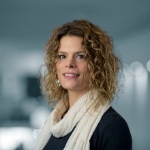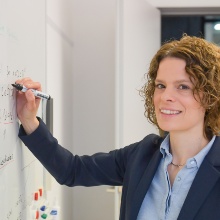It is a challenge to explain a publication on basic mathematical research in such a way that even non-mathematicians can understand it or at least get an idea of what it is all about. The two mathematicians Prof. Dr. Andrea Barth and Robin Merkle agree on this. Barth is the head of the research group “Computational Methods for Uncertainty Quantification” at the Institute of Applied Analysis and Numerical Simulation (IANS) as well as a PI at the SimTech Cluster of Excellence. Robin Merkle completed his Master’s degree in Mathematics at the University of Stuttgart and is pursuing doctoral degree studies in the research group of Prof. Barth.
Original publication
R. Merkle and A. Barth (2022). Subordinated Gaussian Random Fields in Elliptic Partial Differential Equations. Stoch PDE: Anal Comp, 2022, https://doi.org/10.1007/s40072-022-00246-w
“We want to develop a model which we can use to describe real-world processes, such as the development of share prices or the strain capacity of materials,” Andrea Barth explains. “However, these processes are so complicated that an exact description is difficult to manage. That’s why we have to abstract.”
One example she cites is the following situation: A city has a fresh water source and a landfill. How can substances from the landfill be prevented from penetrating into the fresh water source and contaminating it? This problem could be solved using a stochastic model that describes the subsoil of the landfill and its properties in an abstract way. Abstract, because the properties are so complex that they cannot really all be included. In addition, an abstract model has the advantage that it can be applied to other situations.
The aim of such a model would be to make a recommendation to the city on where the landfill should be situated, since that is where the likelihood of contamination is lowest as well as where the financial cost is acceptable.
To stay with this example: The subsoil is not homogeneous, but rather has regions that have a higher permeability than others. Unfortunately, the material cannot be scanned completely in order to identify the different areas. A solution to this problem is stochastic modeling, which includes the permeable regions. “The entire subsoil can be modeled using random fields,” Barth explains. The stochastic model can then make a prediction about how the material is going to behave and how likely it is that a certain amount of pollutants will be able to penetrate it. “With our mathematical models, we make predictions about probabilities,” says the mathematician and adds: “This doesn’t necessarily mean that they will be correct; it’s also possible that we are wrong.” But the stochastic model provides an assessment. According to the SimTech scientist, everyone calculates probabilities, for example, to estimate certain risks when making a decision.
“Our stochastic models do not refer to a specific application, but are constructed in a very general way. With the abstract model, we can then map completely different processes or problems and are not limited to a specific application,” Robin Merkle explains. “The more abstract the stochastic model is, the easier it can be generalized.”
In this way, the researchers are creating a “tool” that can be used by scientists from various disciplines, who adapt it to their applications and develop it further as needed. The SimTech Cluster of Excellence is giving the two researchers the opportunity for interdisciplinary dialog with other scientists. They are also in contact with the materials scientists from the Collaborative Research Center (SFB) 1313 “Interface-Driven Multi-Field Processes in Porous Media – Flow, Transport and Deformation”.
“Our models are sometimes used in fields that we hadn’t even thought of. My motivation is to find solutions to a mathematical problem,” says Barth, “and you need to be creative to do that. The solutions also advance mathematics.”

Andrea Barth
Prof. Dr.Head of Examination Committee Bachelor Mathematik B.Sc. Head of Group






